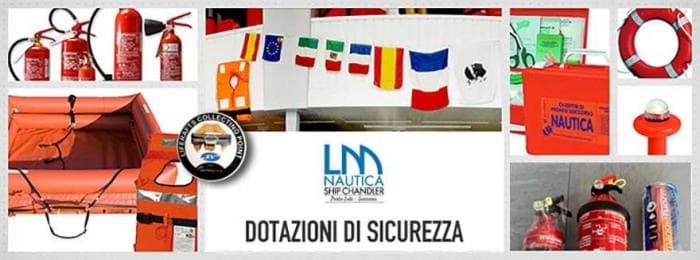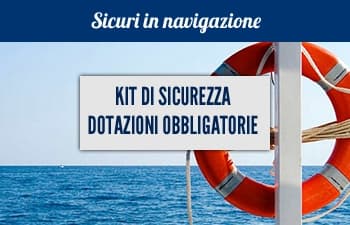Onboard Features and Safety
Never get caught unprepared when sailing! Therefore, before setting sails check for all safety equipments to be intact and no medicine is missing. We offer you, beyond all essentials, even the rescue sings tables and international codes to be displayed on the bridge. Remember that all those on board need to be able to perform a VHF emergency/rescue call, to know the location of all the equipment, to be able to start the engines or to stop the boat, to use the life-raft, the lifebuoy and safety jacket, signaling flares and emergency kit. Fair winds, sailors!
- Audible warning devices
- Emergency kits
- Safety jackets with several homologations for different uses
- Life-rafts – Revision center for life-rafts of all firms
- Lifebuoys and accessories
- Fire extinguishers and accessories
- Trumpets, whistles and bells
- Flags and poles, full dressing and international codes
- Homologated stickers
- Security lights
Safety jackets
Safety jackets are devices supporting a person with the head out of the water, even when unconscious. In fact, the jacket makes sure that the person floats on the back, even in rough seas, assuring the repositioning for the aerial airways to be clear. This is the reason why the jacket should be patented by RINA, or by another entity authorized by the State. Essential requirements for a safety jacket are the CE mark and the ISO 12402 label. The law states that every boat has to have on board enough safety jackets for all the persons on board. The CE mark displays a number, expressing the floating push of the jacket, in Newton (N). For instance, 100 Newton = about 10kg of thrust. You have to keep on board one belt for each adult, not less than 100 N, and one not less than 60 N for each boy, girl or child.
Class 50N Jacket
They are called “Buoyant aids”. Mainly used in sport activities, where an immediate rescue is available. Warning: these jackets are not part of the mandatory on board equipment.
Class 100N Jacket
Suitable for adults and children not able to swim, in favorable weather conditions, and the chance to expect rescue. Straightening with head away from the water in about 10 seconds, even if unconscious. Suitable for boats in navigation up to 6 nautical mile far from the coast.
Class 150N Jacket
Suitable for adults and children in unfavorable weather conditions, with the chance of waiting for rescue even in flowing waters. Straightening with head away from the water in about five seconds, even if unconscious. Suitable for boats in navigation up to 6 nautical mile far from the coast.
Class 175N Jacket
Suitable for navigation in high seas, even in extreme weather conditions, with possibility to wait for rescue even for long time and in rough seas. Straightening with head away from the water in about five seconds, even if unconscious. Suitable for all kind of boats. There are several types of safety jackets in the market: stole-like, bodice-like and inflatable. The stole and bodice jackets are the most popular ones, they are made of expanded foam, an extremely light material which doesn't absorb the water. The stole-like jacket is the cheapest one, and protects essentially the abdomen, leaving the back clear, while the bodice-like one definitely gives more protection, embracing all the chest, allowing a faster straightening. The inflatable jackets are allowed in navigation, provided that the inflation system is automatic, nor manual or by blowing. They are smaller and easier to store, allowing a better comfort in moving on board. In the automated models, when touching water, the jacket is inflated automatically and instantly, safeguarding the shipwrecked person.
Nautical fire extinguishers
Here at LM Nautica, we are seafarers, and we know how much the danger of fire on board is high! For this reason, fire extinguishers are a mandatory equipment, more than just a simple sense need. How do we choose? First of all, each extinguisher must be homologated by RINA, and report its fire class. The minimum amount of fire extinguishers we have to keep on board and their respective power class depend on the boat. A periodic revision is not required, in any case the extinguisher must be stored in a good state and the indicator needs to be in its green zone (charged position).
Fire classes
The alphabetical class (A, B, C, D) describes the fire class the fire extinguisher is suitable to be used for. On recreational units, fire extinguishers from fire class A or C are also suitable, provided that they're homologated for the fire class B as well.
Class A fires: Fires generating from solid materials forming coals, except for metals (wood, paper, plastics, textiles, etc...)
Class B fires: Fires generating from inflammable liquids (fuel, gasoline/petrol, alcohol, etc...)
Class C fires: Fires generating from inflammable gasses;
Class D fires: Fires generating from metals;
Class E fires: shows that the extinguisher is suitable on live electric instrumentation in use.
The most common classes in use in the marine environment are: Class A – B and C fires.
Extinguishing power
The capacity of extinguishing the fire in the specific fire class is provided as a number, showing the features of the extinguishing material and the capacity of the extinguisher's tank: the higher the number, the higher the extinguishing power. The extinguishing power must be reported on the fire extinguisher by the law.
Extinguishers models
Powder extinguishers. This model of extinguisher contains extinguishing powders, manly made of chemical, saline compounds, extinguishing the fire by suffocation.
Foam extinguishers. These extinguishers use foaming agents to extinguish the fire. They are not suitable on live electric instrumentation in use, as the foams used are diluted in water solutions.
Carbon dioxide extinguishers. These type of extinguishers works by suffocation and by cooling, and it is recommended for live electric or electronic instrumentation because of its great ability to leave no traces of residues. The efficiency of CO2 in the open air is highly reduced, and needs to be used with attention in closed environments, due to its suffocating effect.
First aid rules and emergency kits
Emergency kits are mandatory by the law, according to SM 25 25.05.1988 Nr. 279 - Tabla A. They need to be a firm point of reference on every boat, ad a basic prevention form. The emergency kit box has to be solid, floating and with a waterproof closing system. The amount and the nature of the medical devices is ruled by the law, but we recommend to “enhance it” before the departure, to cover any need. The content of the box homologated for navigation is ruled by the reference law. The DM establishes the content, distinguishing between first aid and medication materials and medicinal products.
- 1 ammonia bottle
- 4 cambric bandages cm 5
- 1 cambric bandage cm 7
- 2 gauze bandages (1 of cm 5 - 1 of cm 7)
- 1 plaster roll m 5x2,5 cm
- 1 pack with 20 plasters
- 5 packs of cotton-wool gr 125
- 1 scissors for cutting bandages cm 14 DIN
- 1 pack of compressed sterile gauzes cm 10x10
- 1 pack of 25 compressed sterile gauzes cm 10x10
- 1 emergency tourniquet
- 6 envelopes of sterile gauzes cm 18x40
- 4 sterile syringes (2 of cc. 5 - 2 of cc.10)
- 2 splints
- 1 Clinical thermometer
- 1 250 ml bottle of disinfectant
- 1 sterile tampobenda (tampon-bandage) mm 80x100
- 1 sterile tampobenda (tampon-bandage) mm 100x120
- 2 envelopes gauzes with vaseline
- 1 bottle hydrogen peroxide
- 1 first aid instructions
Common content for boats with crew on board
The equipment listed above needs to be completed with (reference tabla A attached to decree n. 279 ofl 25.5.1988)
- Analgesics - Antipyretics - Anti-rheumatics
- Analgesics - Antispasmodics
- Antihemorrhagics / Haemostatic
- Antihistamines - Anti-allergies - Anti-shock
- Ointments and creams against burns
- Liquid disinfectants for external use
- Hydrophilic muslin bandage
- First aid manual
- Medication sterile packs of several seizes
- Disposable syringes
- Thermometer





